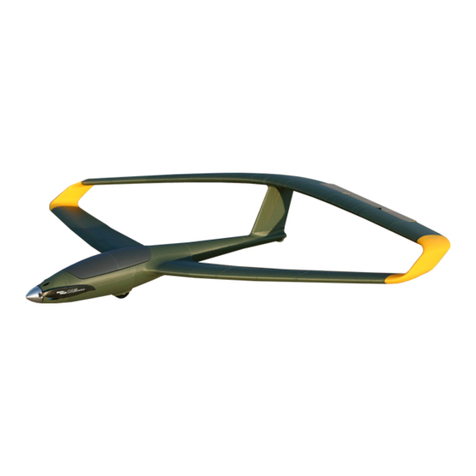
Estimated Part Weights by Material Type (Grams):
Hardware Needed:
- 5mm O.D x 3mm Thick Rare Earth Magnets for Removable Canopy.........................................
- M3 x 0.5mm Thread x 12mm Long Screws for Cowling and Landing Gear.................................
- M3 x 0.5mm Thread x 25mm Long Screws for Spinner.............................................................
- M4 x 0.7mm Thread x 16mm Long Screws for Motor Mount and Wing Mount...........................
- M5 x 0.8mm Thread x 40mm Long Screws for Landing Gear.....................................................
- M3 x 0.5mm Thread Lock Nut for Spinner................................................................................
- M3 x 0.5mm Thread Heat-Set Threaded Inserts for Cowling and Landing Gear.........................
- M4 x 0.7mm Thread Lock Nut for Motor Mount........................................................................
- M4 x 0.7mm Thread Heat-Set Threaded Inserts for Wing Mounts............................................
- M5 x 0.8mm Thread Lock Nut for Landing Gear........................................................................
- Steel washer for M5 Screw Size for Landing Gear.....................................................................
- M2 or #2 Thread Forming or Tapping Screws for mounting servo covers.................................
- 3mm O.D. (or 1/8” O.D) x 10mm Long Dowel Pins (cut from scrap carbon tube/rod)..................
- 6mm O.D. Carbon Fiber Tubes
- 600mm (or 24“) Long for Wings (x6).............................................................................
- 500mm Long for Horizontal Stab.................................................................................
- 220mm Long for Vertical Stab......................................................................................
- 1mm - 1.5mm O.D. Carbon fiber rod or Steel Wire
- 650mm Long for Aileron Hinges (x2)............................................................................
- 550mm Long for Elevator Hinge...................................................................................
- 220mm Long for Rudder Hinge.....................................................................................
- 2mm (or 2-56) diameter steel wire with threaded ends for servo control rods
- 30” for elevator and rudder..........................................................................................
- 12” for ailerons.............................................................................................................
- 1.8mm - 2mm diameter steel wire for tailwheel wire................................................................
- Nylon or Steel Kwik-Links........................................................................................................
- Adjustable Pushrod Connectors (optional)..............................................................................
- Wheel Collars to fit 5mm rod (main landing gear)....................................................................
- Wheel Collar to fit 2mm rod (tailwheel)...................................................................................
- 4” servo extensions for aileron servos....................................................................................
- 6” servo extensions for aileron ports in receiver.....................................................................
Part Name
PLA/LW-PLA Recommended Material
for Hybrid
PLA/PETG
ABS/ASA
149
1
37
137
134
134
100
100 88
100
100 88
Wing Trailing Edge R 13 LW-PLA 23 20
Wing Trailing Edge L 13 LW-PLA 23 20
Wing Tip R 8 LW-PLA 16 14
Wing Tip L 8 LW-PLA 16 14
Wing Servo Covers 15 PLA 15 15
Aileron R1 14 LW-PLA 24 21
Aileron R2 14 LW-PLA 24 21
Aileron R3 14 LW-PLA 24 21
Aileron R4 14 LW-PLA 24 21
Aileron L1 14 LW-PLA 24 21
Aileron L2 14 LW-PLA 24 21
Aileron L3 14 LW-PLA 24 21
Aileron L4 14 LW-PLA 24 21
HorizStab R1 14 LW-PLA 27 24
HorizStab R2 13 LW-PLA 22 19
10
HorizStab L1 14 LW-PLA 27 24
HorizStab L2 13 LW-PLA 22 19
HorizStab L3 10 LW-PLA 1917
41
41
43
43
41
41
43
43
65
ABS, ASA, or PETG 65 (PETG) 57
Vert Stab 1 10 LW-PLA 17 15
Vert Stab 2 11 LW-PLA 1917
Control Horns 11 PLA, ABS, ASA, or PETG 11 11
1938 2817 2507
OPTIONAL
PARTS
Estimated
Weights Recommended Material
Tire 20 TPU/TPE
Tire Hub 1 7 PLA, ABS, ASA, or PETG
Tire Hub 2 7 PLA, ABS, ASA, or PETG
Tailwheel Tire 2 TPU/TPE
Tailwheel Hub 1 1 PLA, ABS, ASA, or PETG
Tailwheel Hub 2 1 PLA, ABS, ASA, or PETG
Spinner 1 25 PLA, ABS, ASA, or PETG
Spinner 2 9 PLA, ABS, ASA, or PETG
Weights





























